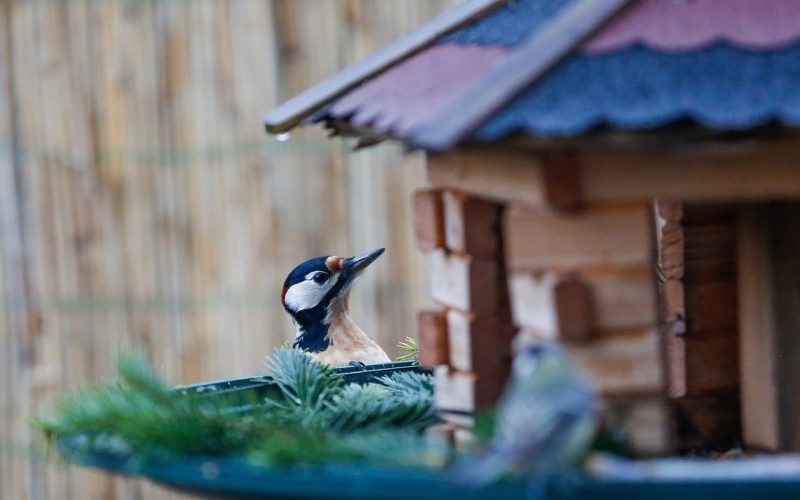Although woodpeckers are lovely to watch, they may also harm your house and trees.
Read through this guide to discover how to stop woodpeckers from pecking houses.
The sound of a woodpecker pecking into your house is one of the few things that can ruin the pleasure of a bright spring morning.
Although birds are often beautiful, their harm to structures and trees is not.
If woodpeckers build nests on your property, they can cause thousands of dollars in damage.
This guide will demonstrate how to stop woodpeckers from pecking your house.
How to Stop Woodpeckers From Pecking House?
Use Decoys
Decoy predators that imitate other animals, like owls or hawks, may be quite successful across a vast region.
This is one of the best methods for stopping woodpeckers from pecking the house. It works best when placed in noticeable areas where they may be seen.
Decoys have the drawback that when birds remain in the same area, they become used to them.
The simplest approach to stopping woodpeckers from pecking the house is to do this.
Your decoys should be relocated every few days to maximize their effectiveness.
Moving them once or twice a week should be sufficient, but try to have as many different perches as possible.
A decoy loses effectiveness when frequently put in the same spot since birds have good memories.
Possessing a variety of decoys that may be used individually or in combination with 6another is a wise strategy.
Although owl and hawk decoys are excellent, they may reduce the activity a bird feeder attracts.
A rubber snake may also work well as a decoy, although the effect is often more restricted.
A rubber snake stapled to the wall where a woodpecker damages the paint should make him pause.
If you don’t want a Staples sign on your wall, wrap the snake around a satellite dish or hang it from a high cable.
Use Mylar Helium Balloons
For others, ascending a ladder more than a few steps might cause crushing terror.
If you have vertigo, shiny helium-filled balloons are a fantastic method of stopping woodpeckers from pecking your house.
Even if you are comfortably positioned on a ladder, the woodpecker may still be squawking high above your head. This is another ideal scenario for the use of mylar balloons.
Mylar balloons’ primary drawback is their short lifespan. Another effective method of stopping woodpeckers from pecking the house is using balloons.
Cover Holes in Your Home
The good news is that woodpeckers only like pecking wood, so if you seal the hole, the animal might leave.
You may want to consider siding, which can improve the appearance of your property and permanently solve your woodpecker problem.
Spackling could be helpful in places where siding cannot be installed, but you’ll need to pick something that matches your house.
Another issue with plugging the hole is that the woodpecker can start working on another area of your building.
Use a Sonic Deterrents
A sonic deterrent is arguably the best option for those who like technology to stop woodpeckers from pecking the house.
These deterrents, which emit a variety of loud bird cries, are effective in an area of up to one acre.
Sonic deterrents may imitate a variety of sounds designed to repel certain species.
These devices mimic distress cries in addition to imitating predatory birds.
According to research, different birds and other animals can recognize certain bird cries.
Some of these sonic deterrent producers went above and beyond to provide various options for the device. The calls may be tailored in style, frequency, and loudness.
Some devices even contain a day and night sensor to guarantee that the appropriate calls are always made.
Use Shiny Objects
Despite having good eyesight, birds cannot distinguish between reflections and actual reality.
Territorial male birds will battle their reflections until they are worn out. You may use their virtue and obstacle combination against them.
Partial reflections might catch a bird’s eye on moving objects, making it difficult for them to relax.
When a disturbance is above, a bird’s ability to fly automatically seeks safety; otherwise, it risks being trapped.
Moving reflections above them consequently makes it especially difficult to feel at ease.
Some birds like shiny objects, yet they get agitated when the shiny things move.
The woodpecker won’t be able to avoid the distraction of hanging a shiny mobile over where he is working.
Netting
If the woodpecker works on a part of your house beneath an overhang, you may hang netting to prevent access.
The bird will often move on to another target, and because there are many net sizes, you shouldn’t have trouble choosing one that fits.
The drawbacks of netting include that it may be pricey and requires roof-climbing to hang and remove.
Additionally, it could be unattractive, and the bird might decide to work from another spot in your house.
Use a Bird Scare Tape
Ultraviolet rays are visible to birds, although most surfaces don’t reflect UV. A reflective ribbon or “bird scare tape” reflects light in the ultraviolet range.
The area the woodpecker is harming might be covered with lengths of bird scare tape that are loosely attached.
Keep the scare tape loose so that the wind may rustle it. This movement scatters light, creates shifting shadows, and might resemble a snake crawling.
A three-pronged attack often uses bird scare tape. Shiny reflective surfaces, UV-reflecting capabilities, and the capacity to simulate snake scales complete the deterring effect.
Use Sprinklers
Using a sprinkler system to keep the area they are interested in wet, you may easily stop woodpeckers from pecking houses since they dislike damp ground.
Although it works well, reaching the woodpecker on a multistory house may be challenging, and if the bird is persistent, this water consumption might raise your water bill and be wasteful.
Methods Not to Be Used in Any Case to Scare Woodpeckers
As an endangered species, the woodpecker is protected; therefore, it is important to keep that in mind. Avoid using tools that might injure woodpeckers, such as nets, spikes, or gels. They are against the law.
Also, avoid attempting to catch or take the eggs away from their nests. Woodpeckers have a crucial role in the environment since it is biological control because they eat insects that weaken trees. If they were to vanish, this might have a bad effect on the woods.
You should take caution while chasing these animals away. They are a protected species, and you cannot hurt them.
Check the area where the woodpecker is pecking for insects that could lure them. If there is an insect swarm, consult a licensed pest treatment business. If you eliminate the insects, the woodpecker may depart the area.
Signs of Woodpecker Damage
Woodpeckers use their unique pecking habit to obtain food and interact with other birds. Their strong, pointed beaks may pierce the wood to extract delicious insects.
Additionally, they use drumming to communicate with one another, primarily to mark territory or exhibit courtship behavior.
However, their interesting antics also make them annoying pests. A woodpecker’s beak may scratch various surfaces when it beats on them repeatedly.
They can drill holes in stucco siding, trees, and wooden buildings. Typical woodpecker damage often appears as a row of tiny, deep holes running vertically or horizontally. There could also be bigger nesting holes.
Due to the noise associated with it and the regularity of the holes, you can generally tell that woodpeckers caused the damage rather than insects. Metal chimneys and gutters may not provide food or refuge for woodpeckers.
However, they may discover that drumming on them generates a considerably louder sound that is better for claiming their territory.
While this generally won’t cause any structural damage to your house, it will certainly cause you a lot of stress in a hurry.
Woodpeckers are nuisance birds, and you don’t want to kill them. They are fascinating and attractive birds and play a crucial role in ecology.
The Migratory Bird Act of 1918 also protects them in the US, even though they don’t migrate. You want to distract them from your house and property rather than kill them.
Conclusion
The best method to stop woodpeckers from pecking houses is using a shiny spiral wind reflector. You may scatter a few around your yard since they are affordable, visually appealing, and noiseless.
The birds won’t get used to it since even a tiny breeze will cause them to turn, causing light to reflect unpredictably in all directions.
They operate all day without maintenance and may be powered by water or electricity without climbing.
Some birds may be able to avoid the other methods to stop woodpeckers from pecking houses, but this does not mean they are ineffective.








